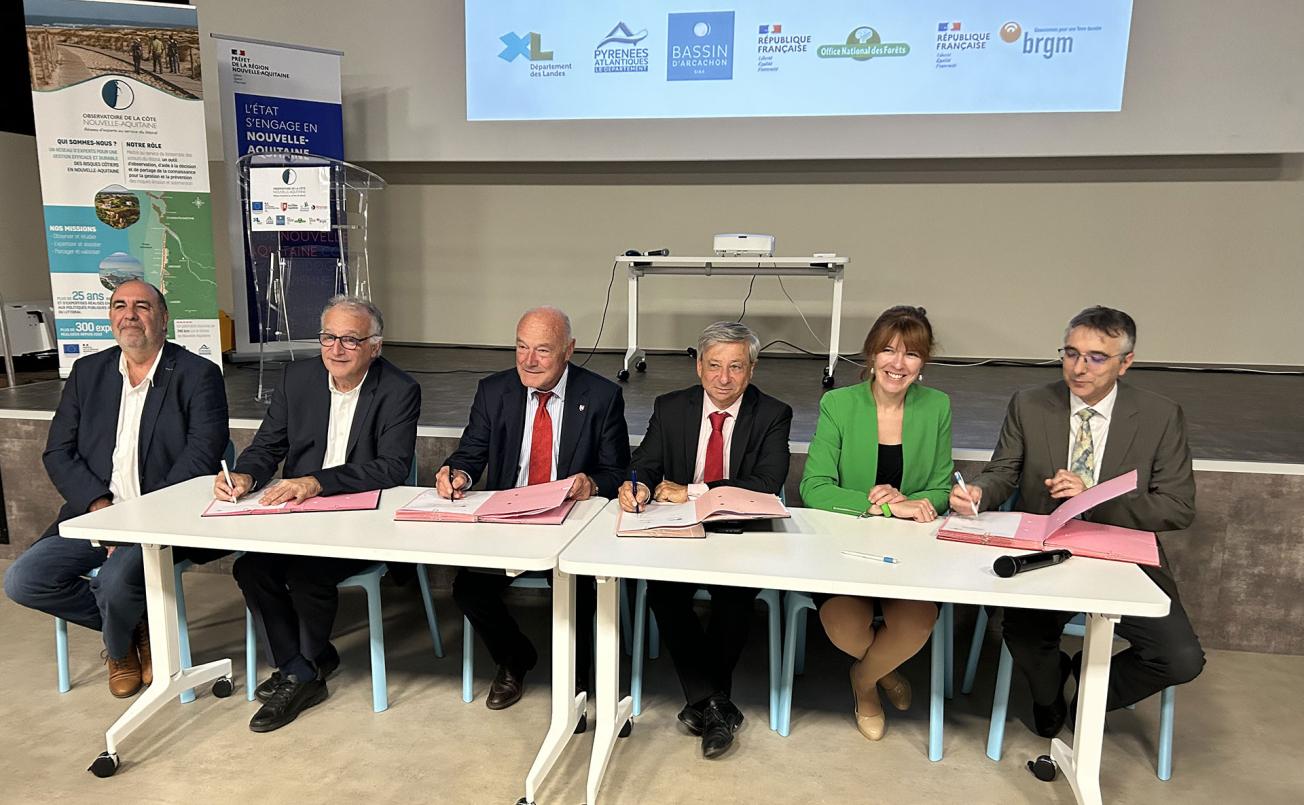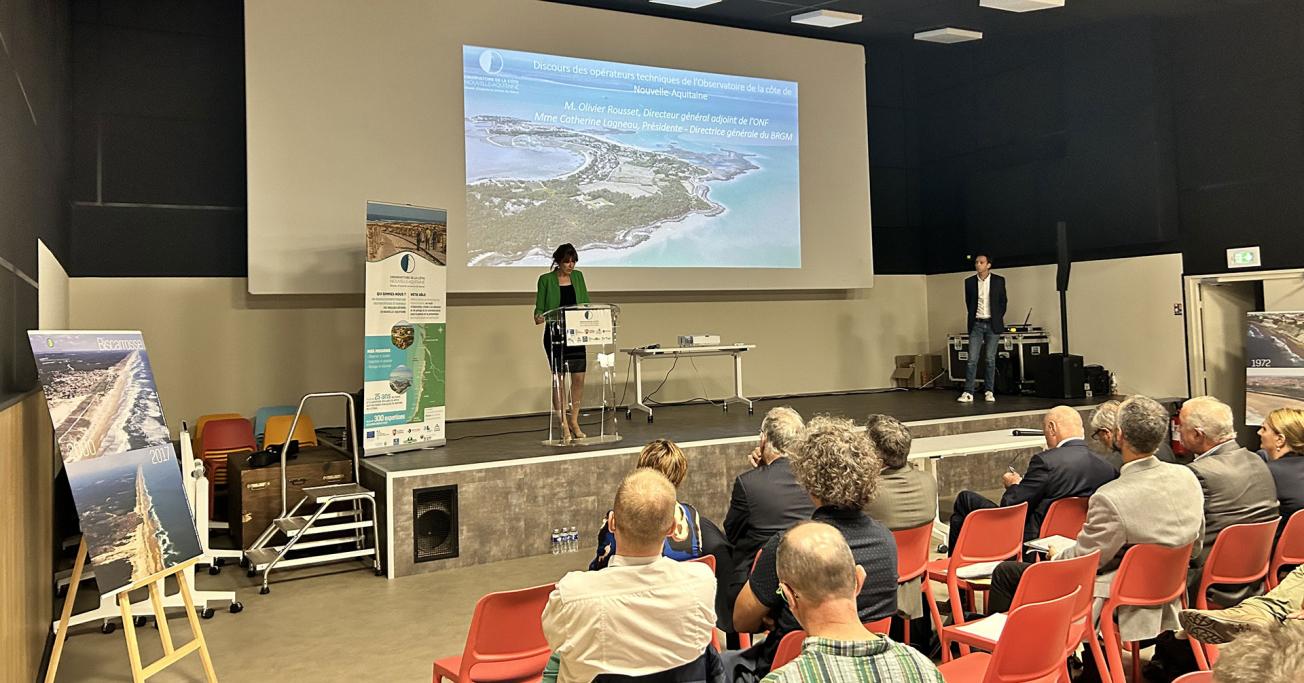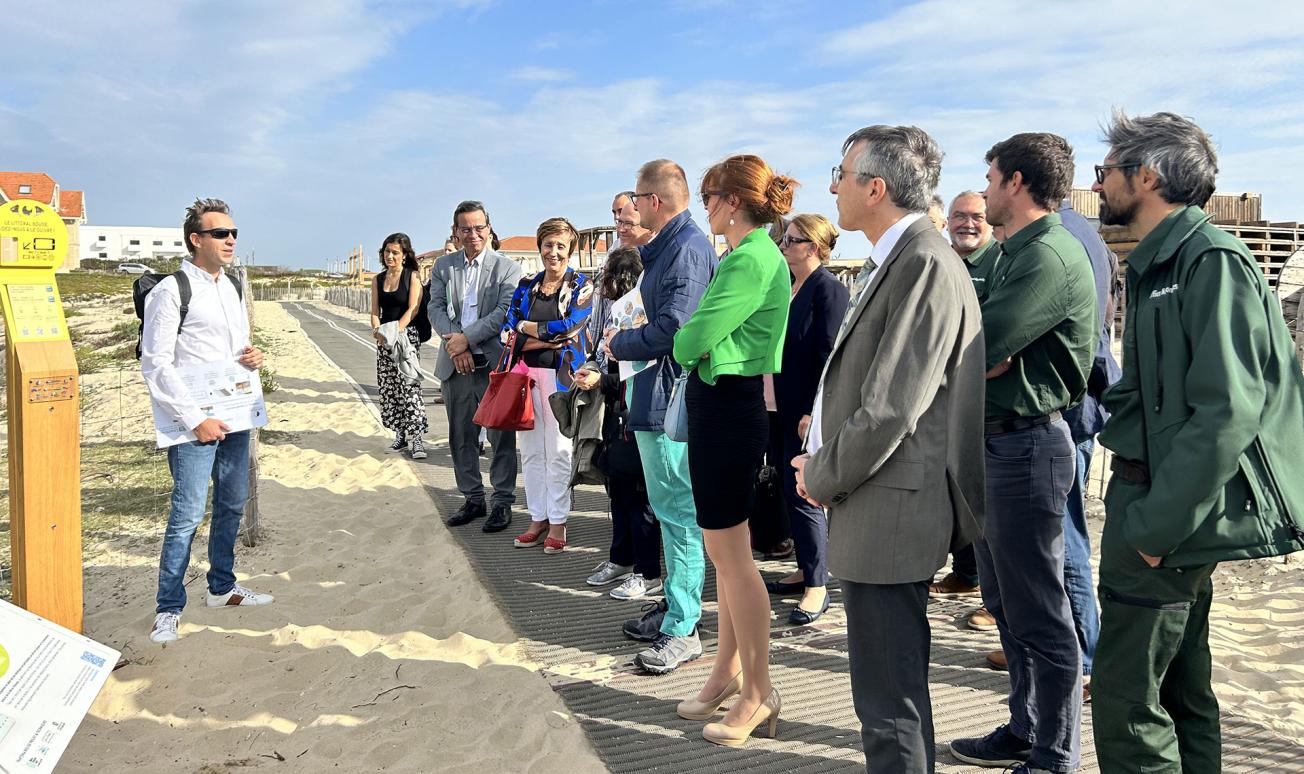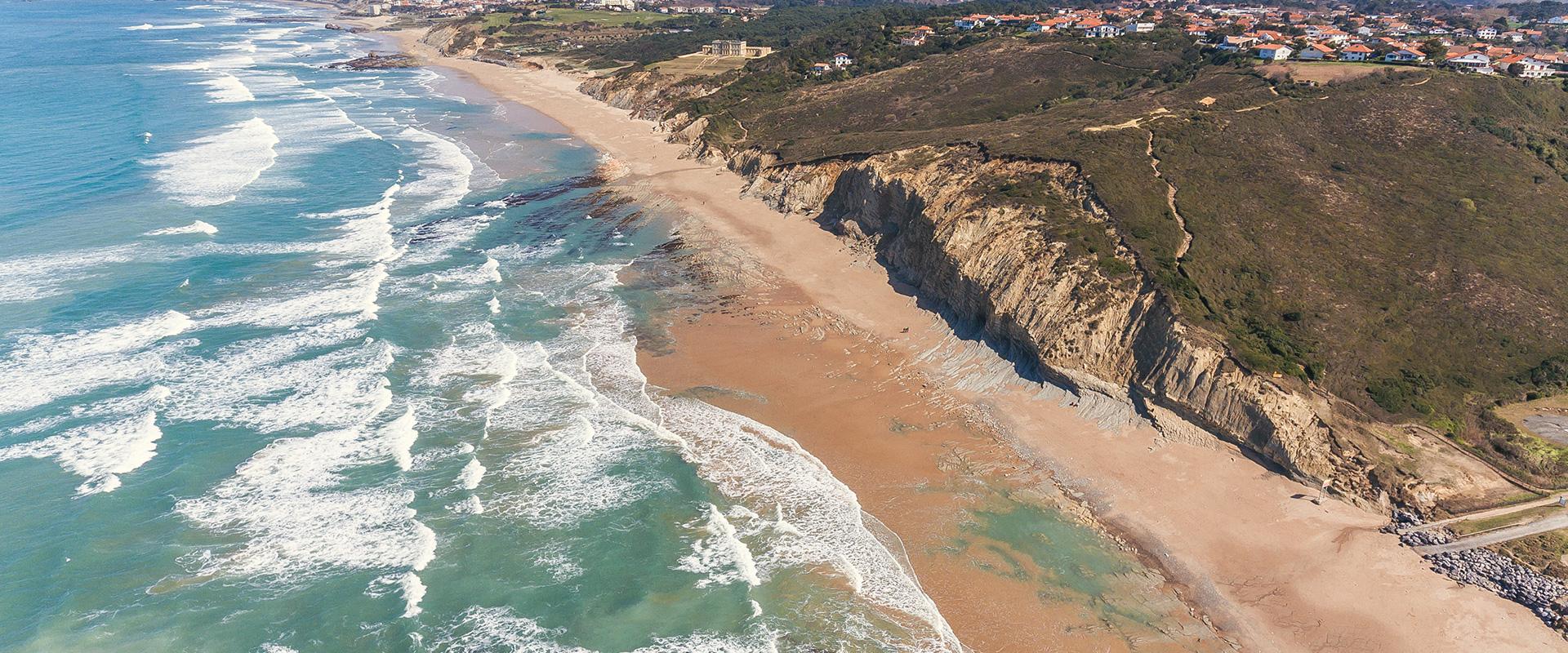
On 13 October 2023, the OCNA partners signed the new agreement for the period from 2022 to 2027. From left to right: Xavier Fortinon, President of the Conseil départemental des Landes, Alain Rousset, President of the Conseil régional de Nouvelle-Aquitaine, Etienne Guyot, Prefect of the Nouvelle-Aquitaine Region, Catherine Lagneau, BRGM Chair and CEO and Olivier Rousset, Deputy Director General of the ONF.
© OCNA
The partners involved in the Observatoire de la côte de Nouvelle-Aquitaine (Nouvelle-Aquitaine Coastal Observatory), which has been monitoring changes to the region's coastline for over 25 years, have reaffirmed their commitment for the period up to the end of 2027.
Aware of the major role played by the Observatoire de la côte de Nouvelle-Aquitaine, the State and the Conseil Régional de Nouvelle-Aquitaine as co-chairs, and their partners have renewed their support in a partnership agreement covering the period 2022-2027. The partners remain convinced of the importance of having a tool for sharing knowledge and expertise of the Nouvelle-Aquitaine Region for characterizing coastal hazards, providing assistance to public authorities and promoting adaptation to coastal risks, which are exacerbated in the context of climate change.
As co-funder of the observatory and jointly responsible for the technical issues along with the ONF, BRGM signed the new agreement with its partners on 13 October 2023.

As co-funder of the observatory and jointly responsible for the technical issues along with the ONF, BRGM signed the new agreement with its partners on 13 October 2023.
© OCNA
Strategic objectives of the 2022-2027 agreement
The 2022-2027 partnership agreement has several strategic objectives:
- Ensuring and optimising monitoring and surveillance of coastal changes
- Providing expertise and assistance to those involved in coastal management
- Strengthening the regional resource centre on coastal dynamics and making data more readily available
- Sharing knowledge, promoting it and communicating with different audiences
- Confirming flexible and appropriate organisational and operational processes
The Nouvelle-Aquitaine coastal observatory
From Aiguillion Bay in the North to the Bidassoa estuary in the South, the Nouvelle-Aquitaine coastline is an outstanding, attractive and well-conserved part of the region, but is facing coastal erosion and flooding events. For almost twenty years in Aquitaine and for more than five years in Nouvelle-Aquitaine, the Observatory has been helping those involved in coastal management to adapt to changes in the coastline and climate change.
Founded in 1996, the Nouvelle-Aquitaine Coastal Observatory (OCNA) was set up to provide coastal stakeholders with a support tool for observation, decision-making and knowledge-sharing for the management and prevention of coastal risks. The aim is to support sustainable development strategies so as to take into account the changing shape of the coastline and the wealth of its natural heritage while simultaneously adapting to climate change.
It is funded by the European Union via the ERDF (European Regional Development Fund), State financing for Nouvelle-Aquitaine, the Nouvelle-Aquitaine Regional Council, the Councils of the Charente-Maritime, Gironde, Landes and Pyrénées-Atlantiques départements, the Syndicat intercommunal du Bassin d'Arcachon, BRGM and ONF. The Observatory's missions are run by the co-funders and technical operators (BRGM and ONF), in close collaboration with the research and consultancy bodies of the Nouvelle-Aquitaine region, the coastal public-interest group (GIP Littoral) and the Conservatoire du littoral.
Some examples of OCNA projects

A field trip was organised with partners from the Nouvelle-Aquitaine observatory to present the CoastSnap system for monitoring the state of beaches at the end of summer in 2023 and the Réseau tempêtes (storm network) system (Biscarosse, 13 October 2023).
© OCNA
Characterisation of the impact of winter storms in 2013-2014
The winter of 2013-2014 was marked by a succession of storms on the Atlantic coast, which had a significant impact on the regional dune belt. Eight storm events were identified between December 2013 and March 2014, four of which have an estimated return period of more than ten years. The coastline has receded by more than 20 metres at many sites. The beaches have become much lower and flatter, thus limiting their resistance and that of the adjacent dunes to the onslaught of the ocean.
CoastSnap: taking photos to understand how the coastline changes
A genuine participatory science initiative, CoastSnap was launched in Australia in 2017, with the aim of quantifying changes to beaches and coastlines by combining photos taken by members of the public with image processing algorithms from coastal imagery research. The concept involves installing observation stations along the coast, where passers-by can take photos from a fixed platform to frame a repetitive picture from an identical perspective.
The Réseau Tempêtes
The OCNA Storm Network, developed between 2016 and 2018, is a network of volunteers whose general mission is to monitor the Nouvelle-Aquitaine coastline, which is subjected to storms and sudden erosive events. It organises and deploys technical and human resources on the Nouvelle-Aquitaine coast, and brings together specialists to understand storm phenomena and share information on their impacts.
An agreement that reinforces OCNA's missions
The agreement recognises and reinforces the Observatory's 3 main missions, namely to:
- Observe changes in the coastline by mobilising a unique network of measurements and observations on a regional scale, studying the phenomena of coastal erosion and flooding in particular and characterising the impact of storms and changes in flora and fauna to improve our understanding of the coastline and increase scientific expertise.
- Support public authorities by providing them with objective scientific knowledge and technical know-how to help them make decisions and manage the Nouvelle-Aquitaine coastal environment.
- Communicate by providing the general public and authorities with up-to-date data and information on the coast, in order to share knowledge and develop a culture of risk management.
Nouvelle-Aquitaine coastline now fully covered
This renewed partnership agreement marks the inclusion of the Conseil départemental de la Charente-Maritime in the partnership. The Observatory now covers the entire coastline of Nouvelle-Aquitaine. This enables a concerted effort by local stakeholders who wish to work together to better understand, preserve and manage the Nouvelle-Aquitaine coastline, with a view to meeting current and future challenges.





